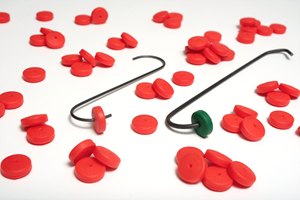Blistering After E-Coat
We are currently experiencing problems with blistering/bubbles after e-coat on zinc-plated, non-chromate steel stampings.
Q. We are currently experiencing problems with blistering/bubbles after e-coat on zinc-plated, non-chromate steel stampings.
This seems to occur along the outside edges where the zinc is most thickly applied. We’ve tried to reduce the plating in this area but have then had problems meeting the minimum thickness required per the standard in other areas.
I have also heard that gases are trapped in the zinc, and if not given time to properly cure before e-coat these bubbles will occur after e-coat is applied. Is this true?
The plating and e-coat are both being done by outside sources, and both tell me that I will not be able to 100% eliminate this problem as e-coat over zinc is not a good design practice. I would really like to resolve this issue. Any help or advice you could offer would be greatly appreciated. S.S.
A.As far as e-coating over zinc plate not being a good design practice is concerned, I would strongly disagree. However, there are alternatives and challenges in doing this two-coat process. Assuming both coatings are being used to provide corrosion resistance, either may be adequate alone depending on salt-spray or other requirements. As a non-organic coating, zinc plate also has significant abrasion resistance.
If corrosion resistance is the only reason for the coatings, then electeocoat alone will compete with zinc plate. The combination does provide more corrosion resistance, if the coatings are applied correctly.
The problems with blistering/bubbles that you refer to are probably not due to gases being trapped in the zinc if not given time to cure before e-coat, as you heard. They are more likely coming from a clear coat applied to the zinc plate as a “final seal” of the zinc plate to reduce oxidation of the plating.
This issue was addressed in my December 2005 Clinic. The following is an excerpt from that issue:
Most platers add a clear chromate sealer over their zinc plate. These clears are normally organic in nature and can be/are removed with strong hot alkaline cleaners. You may see variations in the amount of clear on the part and removed in your cleaner stage.
In my experience as a custom coater, I had some success in getting customers (or their platers) to eliminate the clear over the zinc plate. Your zinc phosphate will work much better if the clear is eliminated as it can react with the zinc surface directly.
If the clears cannot be eliminated or completely removed, your zinc phosphate will be “hit and miss” and the defects you describe may result. The clears that platers use are not normally baked and if they are not removed, they could blister under the e-coat after the e-coat bake.
If the clear is not eliminated or removed, you are really e-coating over the clear chromate and are not giving your customers the quality they are expecting. The zinc phosphate over zinc plate plus the e-coat substantially increase the corrosion protection of the parts.
Try getting samples from your customer without a clear and run them with regular parts as a control. Or soak some parts in a strong solvent (like MEK) to remove the clear before processing, again running with some control parts.
If your e-coater does not have a strong alkaline cleaner or is using iron phosphate versus zinc phosphate pretreatment, this will create more challenges if the zinc plate has a clear coating. The best solution is to get the plater to eliminate the clear and the e-coater to coat the plated parts before any oxidation of the zinc plate occurs.
Related Content
Installing an Ecoat Line
Thinking of investing in electrocoating capabilities? George Lovell, coatings plant manager for Lippert, discusses considerations you should keep in mind as you add your ecoat line.
Read MoreTake Full Advantage of Industry Events
As travel plans ramp up for the year, what industry events will you attend? Products Finishing offers a quick look at some of the upcoming opportunities for 2024.
Read MoreCFS Unveils New Hook Locks Parts Racking Solution
New product from Custom Fabricating & Supplies (CFS) prevents part loss during coating processes.
Read MoreTTX’s Automated Conveyor Carrier System Offers Wireless, Flexible Operation
ACC system designed for reliable, consistent point-to-point movement of everything from small to heavy parts.
Read MoreRead Next
Episode 45: An Interview with Chandler Mancuso, MacDermid Envio Solutions
Chandler Mancuso, technical director with MacDermid Envio discusses updating your wastewater treatment system and implementing materials recycling solutions to increase efficiencies, control costs and reduce environmental impact.
Read MoreA ‘Clean’ Agenda Offers Unique Presentations in Chicago
The 2024 Parts Cleaning Conference, co-located with the International Manufacturing Technology Show, includes presentations by several speakers who are new to the conference and topics that have not been covered in past editions of this event.
Read MoreDelivering Increased Benefits to Greenhouse Films
Baystar's Borstar technology is helping customers deliver better, more reliable production methods to greenhouse agriculture.
Read More













.jpg;maxWidth=300;quality=90)










